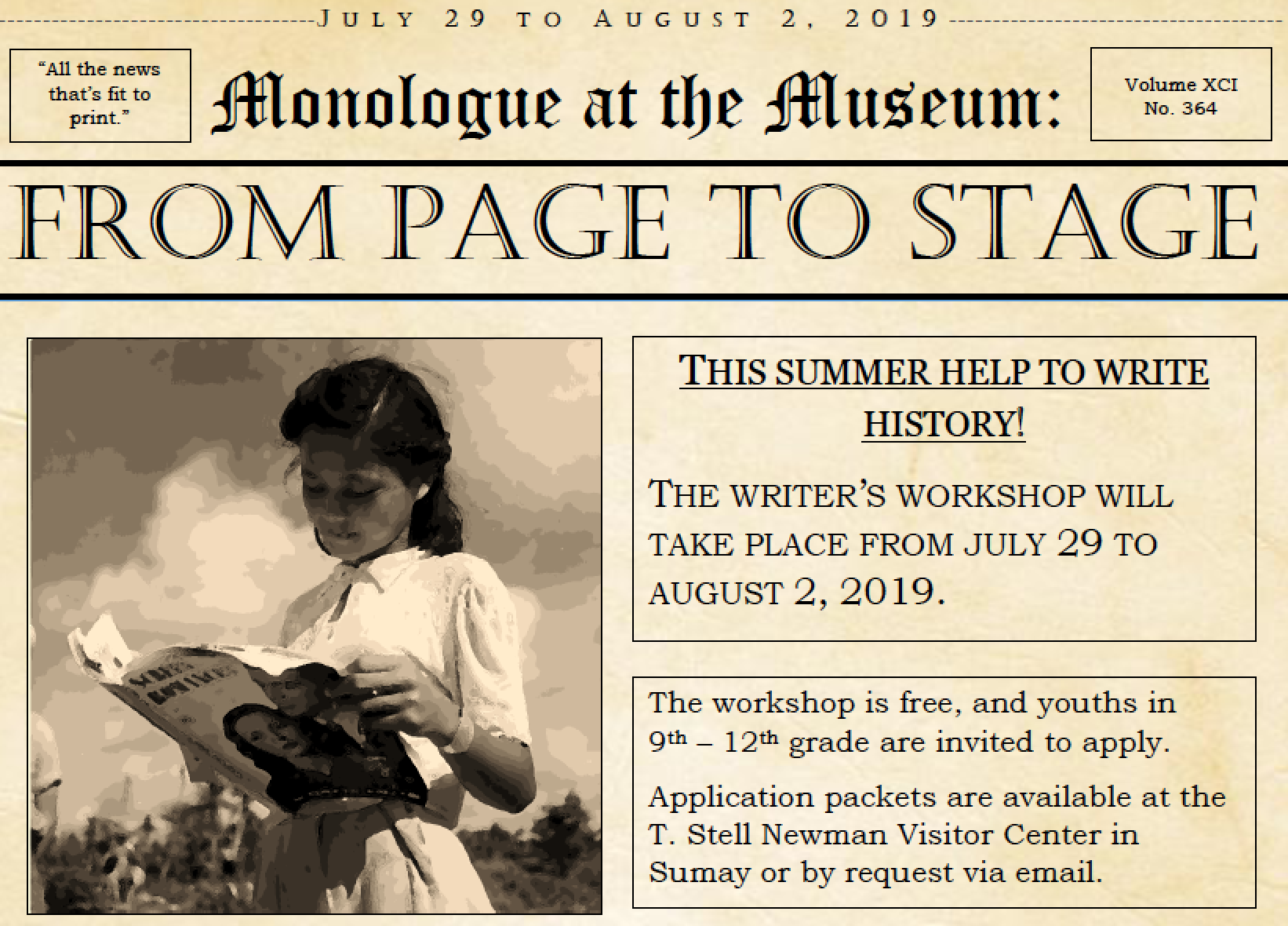Monologue at the Museum 2019

Monologue at the Museum 2019
- Status: Past Project
- Possible Hours: 10
- Categories: Education and Literacy, History and Culture
- Schools: Open to All Schools
- Project Start Date: 07/29/2019
- Project End Date: 08/02/2019
Students must submit the application form by the deadline of July 21, 2019. The application form consists of essay and short answer questions as well as two writing samples. If they are chosen, they will be given directions daily on how to prepare for the next day.
Students will spend the mornings in learning experiences such as exploring the National Park Visitor's Center and Museum, Asan Beach Park, the Asan Memorial Lookout, the Micronesian Area Reserach Center, Hagatna historical sites, the Chagui'an Massacre site, and the Guam Museum. Every day, they will be given instruction on the writing process and will work on their monologues. The expectation is for them to go through several drafts so that their finished piece on Friday is in performable shape. On Friday, families, friends, and the public are invited to hear them read the final drafts of their monologues.
In order to earn service learning hours, students will need to write a reflection on their experience at this workshop. They will need to answer these questions: What did you do to earn service learning credit? What did you learn? What was this service? That is, how does this project show that your service was a contribution to the community?
Fine Arts: Theater Standard 2: Creating
Students will engage in the artistic process, acquire skills, and use them to communicate meaning in an original work of art.
HSP.2.2: Write dialogues and scenes, applying basic dramatic structure: exposition, complication, conflict, crises, climax, and resolution.
Language Arts Standard 4: Writing Purposes, Processes, and Strategies
Students use a wide range of strategies and resources to gather and synthesize information and use a variety of writing processes to create and communicate knowledge with a variety of audiences for different purposes.
GRADE NINE-ORGANIZATION AND FOCUS
9.4.1: Plan, organize, and write a coherent composition using precise language.
Example(s): Discuss ideas for writing with classmates, teachers, and other writers and develop drafts alone and collaboratively.
Establish a coherent thesis that conveys a clear perspective on the subject and maintains a consistent tone and focus. Use action verbs, sensory details, and appropriate modifiers to clarify ideas.
9.4.2: Write biographical or autobiographical (personal) narratives or short stories that:
• Describe a sequence of events and communicate the significance of the events to the audience.
• Locate scenes and incidents in specific places.
• Describe with specific details the sights, sounds, and smells of a scene and the specific actions, movements, gestures, and feelings of the characters. In the case of short stories or autobiographical narratives, use interior monologue (what the character says silently to him- or herself) to show the character’s feelings.
• Pace the presentation of actions to accommodate changes in time and mood.
9.4.3: Write expository compositions that are analytical and:
• Gather evidence in support of a thesis (position on the topic), including information on all relevant perspectives.
• Communicate information and ideas from primary and secondary sources accurately and coherently.
• Make distinctions between the relative value and significance of specific data, facts, and ideas.
• Use a variety of reference sources, including word, pictorial, audio, and Internet sources, to locate information in support of the topic.
• Anticipate and address readers’ potential misunderstandings, biases, and expectations.
• Use technical terms and notations accurately.
GRADE NINE-REVISION AND EVALUATION
9.4.4 Edit and proofread one’s own writing, as well as that of others, using an editing checklist with specific examples of corrections of frequent errors.
9.4.5 Revise writing to improve the logic and coherence of the organization and perspective, the precision of word choice, and the appropriateness of tone by taking into consideration the audience, purpose, and formality of the context.
GRADE TEN-ORGANIZATION AND FOCUS
10.4.1 Establish coherence within and among paragraphs through effective transitions, parallel structures, active (I will
always remember my first trip to the city.) rather than passive voice (My first trip to the city will always be
remembered.), and similar writing techniques when writing the following types of essays: autobiographical incident
focused description, literary interpretation (world literature), cause and effect, persuasive, problem-solution.
10.4.2 Write biographical or autobiographical narratives that:
• Describe a sequence of events and communicate the significance of the events to the audience.
• Locate scenes and incidents in specific places.
• Describe the specific sights, sounds, and smells of a scene and the specific actions, movements, gestures, and feelings of the characters. In the case of short stories or autobiographical narratives, use interior monologue (what the character says silently to him- or herself) to show the character’s feelings.
• Pace the presentation of actions to accommodate changes in time and mood.
10.4.3 Write analytical expository compositions (essays, summaries, or literary analyses) that:
• Gather evidence in support of a thesis (position on the topic), including all relevant perspectives.
• Communicate information and ideas from primary and secondary sources accurately and coherently.
• Make distinctions between the relative value and significance of specific data, facts, and ideas.
• Use a variety of reference sources, including word, pictorial, audio, and Internet sources to locate information in support of a topic.
• Anticipate and address readers’ potential misunderstandings, biases, and expectations.
• Use technical terms and notations correctly.
Social Studies Standard 2: History: Students learn how human beings view themselves in and over time.
Guam History: GH.2.1 Examine and interpret primary and secondary source documents.
GH.2.2 Use concepts, such as time, chronology, causality, change, conflict, and complexity, to explain connections and patterns of historical change and continuity.
GH.2.3 Identify and describe historical periods and patterns of change during the eras of Guam history, including the following:
• U.S. Naval Government
• Japanese Occupation
• Post World War II
Acknowledged by Teacher/Guidance Counselor:
Print name: _____________________________
Signature:_______________________________
Date:______________________









